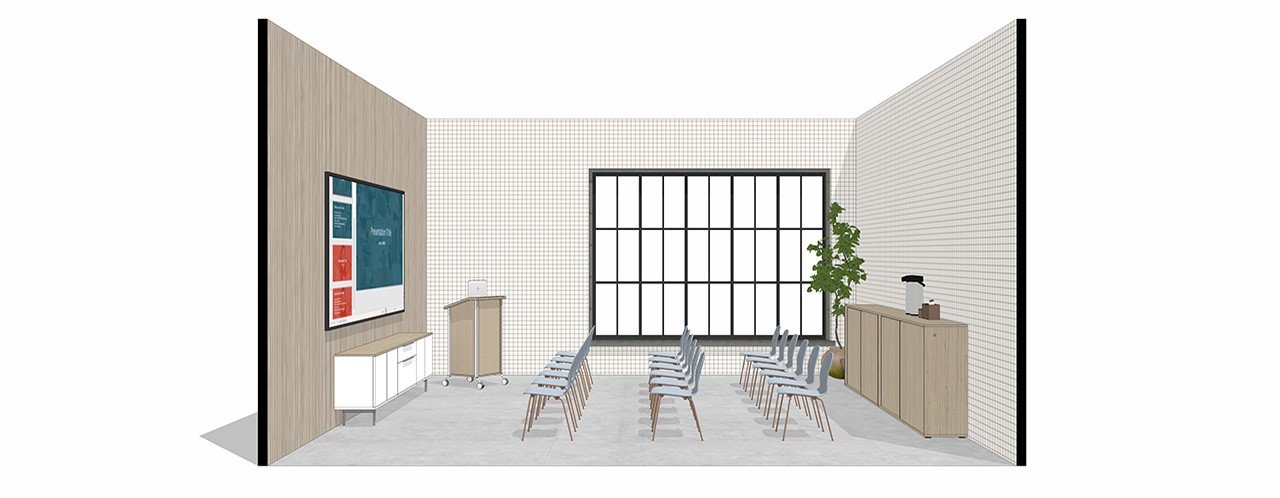4 Types of Collaborative Spaces
When people work together, great ideas are born and connections are made. People learn from one another. And project progress happens faster. As technology has expanded our ability to work from anywhere—including home—we increasingly seek out opportunities to collaborate and connect face-to-face with our teams.
Designing for collaboration helps create an environment where people feel valued for their unique experience and input. Haworth’s global research team has distilled the reasons we meet into 4 primary collaborative activities—inform, do, think, connect—and here’s how you can design workspaces to support each:
1. Inform
To accommodate information sharing, presentation spaces are usually equipped with monitors and conference chairs oriented toward a presenter. We tend to use these spaces to visually share information and data, learn from a trainer, or hear from a guest speaker. People are encouraged to listen to the presenter and ask questions at specified times, such as at the end of the presentation in the case of a speaking engagement, or they can collaborate with one another during a training session. At Haworth, spaces designed for information sharing enable collaboration for large department-wide meetings, guest speakers, and client engagements.
The local chapter of Toastmasters finds these types of spaces at our headquarters ideal for their presentations. Haworth Surface Materials Engineer Kris Pierce explains, “The space our club uses is flexible enough to accommodate a wide range of members and enables speakers to illustrate their topics using technology or whiteboard space that can be easily viewed by all.”
2. Do
To accomplish tactical objectives, people need spaces that include a table, comfortable desk chairs, storage, video and interactive data sharing-technology, and whiteboards. This type of workspace is dedicated for use by groups or teams, and their notes often remain on whiteboards or tacked to walls even when they are working elsewhere. Also called “war rooms,” these tactical spaces are used by our teams at Haworth to track and share projects, metrics, and data.
3. Think
People need spaces for idea generation, brainstorming, and strategic thinking. Usually designed with an informal atmosphere, these spaces typically have comfortable seating—such as sofas or guest chairs—some privacy to avoid distracting others, a monitor, and a whiteboard area to take notes and work through ideas. Groups that benefit from this type of workspace strive to do things first, have a high degree of experimentation and individuality, take risks, and are quick to adapt. At Haworth’s headquarters, areas designed for gathering are enabled with technology that allows employees to share, collaborate, and generate ideas from anywhere.
4. Connect
Primarily created to foster spontaneous interaction and personal connection, Social Spaces serve as the new "watercooler." These people-centered spaces are relaxed, informal, and cozy, and may include lounge chairs, sofas, and rugs to bring warmth and comfort—indoors or out. They offer immense flexibility with moveable furniture: Create a coffee shop and tech bar by day, then accommodate recognition, networking, and other special events at night.
Most organizations use all 4 collaboration spaces to meet the needs of their groups. Based on an organization’s culture type, one method of collaboration will likely be preferred over another—best supporting a team’s primary responsibilities and choices.
For example, a Collaborate culture emphasizes the value of teamwork and operates as a close-knit group. That work environment will be dominated by Social Spaces that allow for connection and a mix of activities. Inform, think, and do spaces are still needed, but will not be as prevalent. In a Control culture, on the other hand, you’ll see more spaces for information sharing, where process-driven, formal meetings are the norm. Still, teams might need to determine project plans and are likely to have some Social Spaces for informal, social connections.
Considering the needs of your organization’s teams is key to Haworth’s Organic Workspace approach—creating a work environment that aligns the effectiveness of people and the efficiency of real estate. We know from our research that taking a break to socialize with colleagues increases our happiness, and people prefer comfortable spaces. The fastest growing collaborative spaces are Social Spaces—which benefit all culture types—are flexible, communal, and inspiring, so people can pause, gather, connect, and restore.





